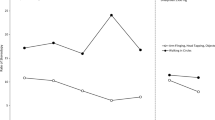Abstract
The effects of haloperidol and a mild punishment on the severe self-injurious behavior and several collateral behaviors of a 17-year-old profoundly retarded male were assessed. A 12-month analysis using a withdrawal design suggested that neither the medication nor the behavioral intervention alone was effective in significantly reducing the frequency of self-injurious behavior. When combined, however, these interventions produced dramatic reductions in the subject's self-injurious behavior. The haloperidol may have acted as a “setting event”for the successful use of the punishment. Suppression of this behavior was maintained at 6 months and 1 year following the end of the analysis. The collateral behaviors were differentially affected by the behavioral and pharmacological interventions. Time spent in bed and the appearance of drooling increased with the introduction of the haloperidol, while percent correct on a fine-motor task increased only when the interventions were applied simultaneously. The results point out the importance of a careful behavioral analysis for both pharmacological and behavioral interventions and their possible combined actions.
Similar content being viewed by others
Reference note
Durand, V. M.Assessment of self-injurious behavior in a retarded male: A case of multiple motivations. Paper presented at the 13th Annual Convention of the Association for Advancement of Behavior Therapy, San Francisco, 1979.
References
Bachman, J. A. Self-injurious behavior: A behavioral analysis.Journal of Abnormal Psychology, 1972,80, 211–224.
Bijou, S. W., & Baer, D. M. Child development I: A systematic and empirical theory. Englewood Cliffs, New Jersey: Prentice-Hall, 1961.
Campbell, M. Biological interventions in psychoses of childhood.Journal of Autism and Childhood Schizophrenia, 1973,3, 347–373.
Carr, E. G. The motivation of self-injurious behavior: A review of some hypotheses.Psychological Bulletin, 1977,84, 800–816.
Carr, E. G., & McDowell, J. J. Social control of self-injurious behavior of organic etiology.Behavior Therapy, 1980,11, 402–409.
Carr, E. G., Newsom, C. D., & Binkoff, J. A. Stimulus control of self-destructive behavior in a psychotic child.Journal of Abnormal Child Psychology, 1976,4, 139–153.
Favell, J. E., McGimsey, J. F., Jones, M. L., & Cannon, P. R. Physical restraint as positive reinforcement.American Journal of Mental Deficiency, 1981,35, 425–432.
Hersen, M., & Barlow, D. H.Single case experimental designs: Strategies for studying behavior change. New York: Pergamon, 1976.
Lazarus, A. A., & Davison, G. C. Clinical innovation in research and practice. In A. E. Bergin & S. L. Garfield (Eds.),Handbook of psychotherapy and behavior change. New York: Wiley, 1971.
Lovaas, O. I., & Simmons, J. Q. Manipulation of self-destruction in three retarded children.Journal of Applied Behavior Analysis, 1969,2, 143–157.
Repp, A. C., & Deitz, S. M. Reducing aggressive and self-injurious behavior of institutionalized retarded children through reinforcement of other behavior.Journal of Applied Behavior Analysis, 1974,7, 313–325.
Romanczyk, R. G., Colletti, G., & Plotkin, R. Punishment of self-injurious behavior: Issues of behavior analysis, generalization, and the right to treatment.Child Behavior Therapy, 1980,2, 37–54.
Romancyzk, R. G., & Goren, E. R. Severe self-injurious behavior: The problem of clinical control.Journal of Consulting and Clinical Psychology, 1975,43, 730–739.
Russo, D. C., Carr, E. G., & Lovaas, O. I. Self-injury in pediatric populations. In J. Ferguson & C. B. Taylor (Eds.),Advances in behavioral medicine. Holliswood, New York: Spectrum, 1979.
Smolev, S. R. Use of operant techniques for the modification of self-injurious behavior.American Journal of Mental Deficiency, 1971,76, 295–305.
Sprague, R. L., & Baxley, G. B. Drugs for behavior management, with comments on some legal aspects. In J. Wortis (Ed.),Mental retardation and developmental disabilities: An annual review. New York: Brunner/Mazel, 1978.
Thomson, T., & Boren, J. J. Operant behavioral pharmacology. In W. K. Honig & J. E. R. Staddon (Eds.),Handbook of operant behavior. Englewood Cliffs, New Jersey: Prentice-Hall, 1977.
Author information
Authors and Affiliations
Additional information
The author wishes to thank Deborah Herriford, James Mikesell, Gil Langley, Joseph Higgins, Jim's parents, and the staff of Unit 3C of the Northern Virginia Training Center for their continued faith and efforts. The author gratefully acknowledges Paul Dores and Edward G. Carr for their invaluable comments on the manuscript. Special thanks go to Wendy Spiewak Durand for her editorial assistance and inspiration.
Rights and permissions
About this article
Cite this article
Durand, V.M. A behavioral/pharmacological intervention for the treatment of severe self-injurious behavior. J Autism Dev Disord 12, 243–251 (1982). https://doi.org/10.1007/BF01531370
Issue Date:
DOI: https://doi.org/10.1007/BF01531370




